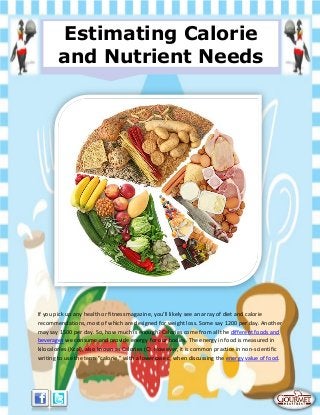
Estimating calorie and nutrient needs
- 1. If you pick up any health or fitness magazine, you’ll likely see an array of diet and calorie recommendations, most of which are designed for weight loss. Some say 1200 per day. Another may say 1500 per day. So, how much is enough? Calories come from all the different foods and beverages we consume and provide energy for our bodies. The energy in food is measured in kilocalories (Kcal), also known as Calories (C). However, it is common practice in non-scientific writing to use the term "calorie," with a lowercase c, when discussing the energy value of food. Estimating Calorie and Nutrient Needs
- 2. When you see the term "calorie" in relation to diet and nutrition, it refers to the kilocalorie. Both calorie and kilocalorie are units of energy. To be precise: 1 calorie = the amount of energy (heat) needed to raise 1 gram of water 1 degree Celsius. 1 kilocalorie (Calorie) = the amount of energy (heat) needed to raise 1 kilogram of water 1 degree Celsius. The fat in the foods we eat provides 9 calories per gram, alcohol provides 7 calories per gram and carbohydrate and protein each provide 4 calories per gram. This is why many health professionals recommend cutting back on fat and empty calories from sugar or alcohol to aid in weight loss. Reducing fat, and sugar and alcohol intake may also reduce risk of heart disease, diabetes and certain cancers. The type of fat you consume does make a difference. For example, olive and canola oil are heart-healthy, while saturate and trans fat and detrimental. However, both types of fat still contain the same amount of calories per gram. The calories (or energy) we consume from food are needed for breathing, metabolizing and absorbing nutrients, maintaining body temperature, thinking and other physiologic functions, including exercise. To maintain body weight, calories you consume must equal calories you burn (through normal bodily functions and/or exercise). When excess calories are eaten and not burned up by the body, the extra calories are stored as fat and result in weight gain. When fewer calories are eaten than are burned, weight loss is the result. You can estimate calorie requirements through a variety of formulas that are based on a person's: ? Height ? Weight ? Age ? Sex ? Activity level Therefore, everyone's calorie requirements are different. In general, most individuals need a minimum of 1200 calories per day to maintain normal physiological functions. If you consume less than this, your body may feel as though it is ?starving? and will lower your metabolism. You will also likely not consume enough calories to meet the RDAs for most nutrients. Very low calorie diets are not advised, though may be used by medical weight loss centers that are monitored by medical personnel. How to Calculate Energy Needs
- 3. Resting Metabolic Rate (RMR) A common formula used to estimate calorie needs is called the Mifflin-St. Jeor Equation (named after the scientists that developed it). It is used to determine a person's RMR (metabolic rate). This represents the amount of energy (calories) the person uses for basic bodily processes, such as breathing and maintaining blood pressure. The RMR does not take into account a person?s physical activity. The formula is as follows: Men: RMR= 5+10 (weight in kgs) + 6.25 (height in cms) ? 5 (age in years) Woman: RMR= 161+10 (weight in kgs) + 6.25 (height in cms)- 5 (age in years) Total Energy Expenditure (TEE) Your TEE, or total energy expenditure, is your RMR multiplied by an activity factor. This is the amount of energy you use during a normal day, including calories for physical activity. To put this in context, your RMR reflects the calories you need to carry out normal bodily functions such as breathing and maintaining body temperature. Your TEE takes into account how active you are. Are you a couch potato, or a marathon runner? The TEE takes into account the extra calories your body needs to keep up with your daily activity. Exercise is the most variable way to adjust calorie needs. The more physically active you are, the more calories your body requires to maintain or gain weight. The following exercise factors are used in calculating your calorie needs for weight maintenance: ? 1.200 = sedentary (little or no exercise) ? 1.375 = lightly active (light exercise/sports 1-3 days/week) ? 1.550 = moderately active (moderate exercise/sports 3-5 days/week) ? 1.725 = very active (hard exercise/sports 6-7 days a week) ? 1.900 = extra active (very hard exercise/sports and physical job) Decreasing your physical activity level, or consuming more calories than your daily TEE will lead to weight gain. Increasing your activity level, or eating fewer calories than your body needs, will lead to weight loss. To lose 1 pound of weight per week, subtract 500 calories per day from your TEE. For example, if your maintenance needs are 2000 calories/day, you would need to limit your intake to 1500 calories per day to lose.
